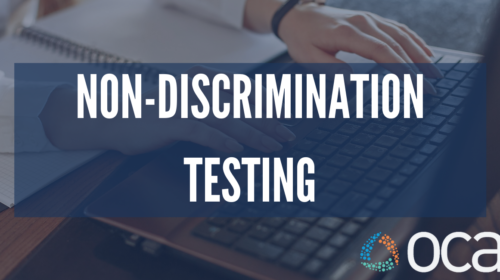What to Know About Non-Discrimination Testing
November 30, 2021 | Quick Alerts

Why Perform Non-Discrimination Testing (NDT)?
If you have a Flexible Spending Account (FSA) or a Premium Only Plan (POP), the IRS requires you complete a non-discrimination test once a year. This is to ensure that a company’s Medical or
Dependent Care FSA treats all employees equally, and do not favor key or highly
compensated employees (HCEs). No employers are exempt from non-discrimination testing.
Three Most Common Reasons Non-Discrimination Tests Fail
• Dependent Care FSA – 55% Average Benefits Test (Utilization)
o Because HCEs typically participate in the DCAP at a much higher rate than non-HCEs, it is not
unusual for a plan to fail the 55 percent average benefits test. The test also includes all
employees, even those not participating, which can negatively impact the average
calculated in the test. To reduce the likelihood of failure, an employer may consider
capping HCE DCAP elections at an amount below the $5,000 maximum.
• Medical and Dependent Care FSA – Benefits Tests
o HFSAs and DCAPs that have disparate waiting periods for a single cafeteria plan tend to favor
the highly compensated causing the test to fail. To reduce the likelihood of failure, tax the
individuals that can enter the plan immediately until the remaining employees can enter the plan.
• Eligibility in the Plan – Eligibility Tests
o Unless enough non-highly compensated individuals are eligible, the cafeteria plan will fail the
Eligibility Test. To reduce the likelihood of failure, make sure enough non-highly
compensated are able to benefit from the plan.
Most Frequently Asked Questions When Completing a NDT Template Used to Perform Testing
• Who to include on the template?
o Include every individual that was employed within your testing year. Active employee
entries will be their annual election. Terminated employee entries will be year-to-date
contributions.
o Do not include individuals that the IRS considers self-employed.
• Does NDT include HSA contributions (E)?
o Yes. The HSA is a part of the POP testing and the FSA testing. You will enter
both the employer contributions and the employee pre-tax expected annual HSA contributions.
• What is meant by compensation (F and G)?
o Annual compensation is basically gross income. For example: Employee makes $125,000 a year.
They enter into salary reduction agreements under the Cafeteria Plan, with contributions
totaling $10,000. This means that for federal income tax purposes, they have a taxable income of
$115,000. Nevertheless, when determining whether they are highly compensated based on
compensation, you will look at the entire compensation of $125,000.
o Current compensation will need to be projected for the year, which can be difficult with bonuses
and commissions. Consider using compensation of prior years to help with the projections.
• Who is an Excludable Employee (M)?
o There are two conditions that must be met. First, an employee must not be able to
participate in the plan (union, non-resident alien, etc.). Then look at the five categories that
are listed. If the reason that they are ineligible is for one of these five categories, enter “yes”
for this column. Do not enter a “yes” for the employee just because they fit one of the five
categories – they MUST be ineligible first.
• Employer Contributions And Employee Pretax Payroll Deductions (H)?
o This column combines employer contributions and employee elections. You are now
including all employer contributions on behalf of the employee combined with the
employee annual pretax deductions. Using just the group medical as an example, if the annual group
medical is $1,500 and the employer pays $1,400 of that premium, the premium portion
entered in this column is the combined $1,500. (However, the entry in the premium column will only
be employee pre-tax portion of $100.00.)